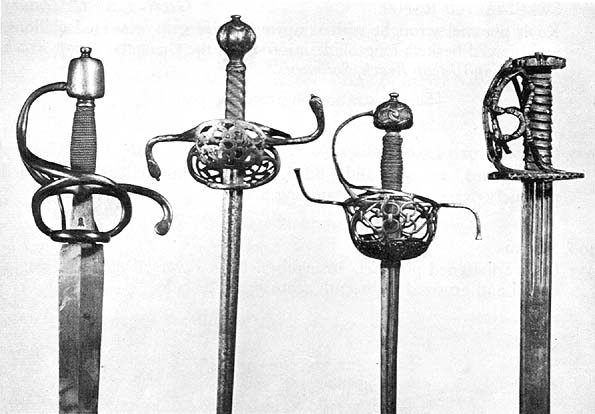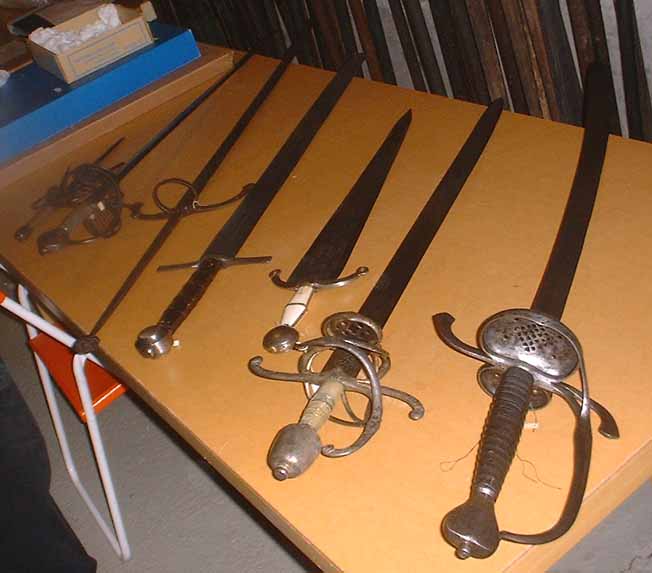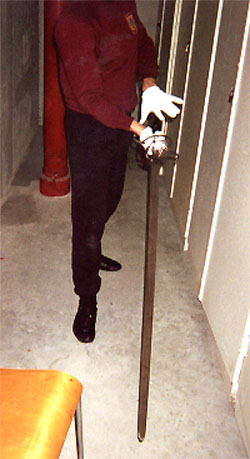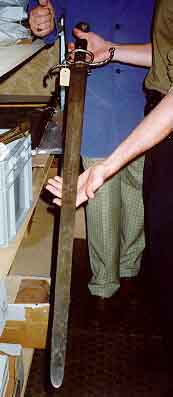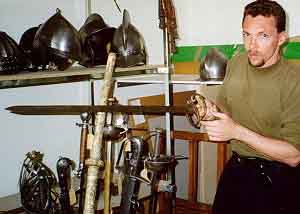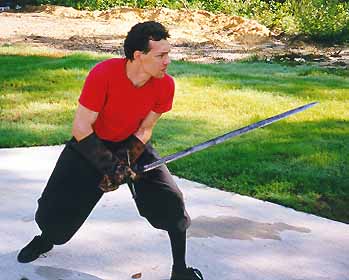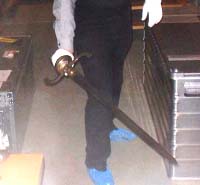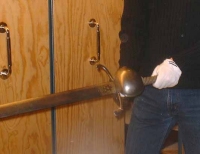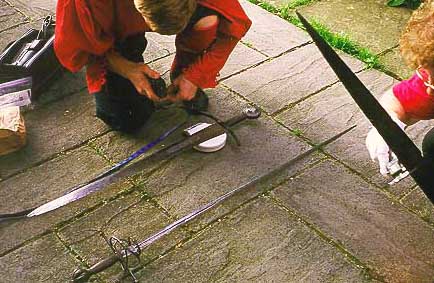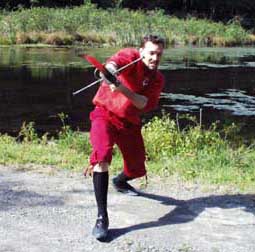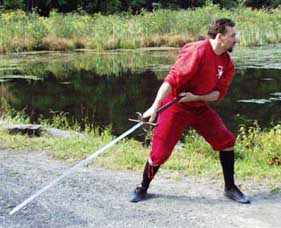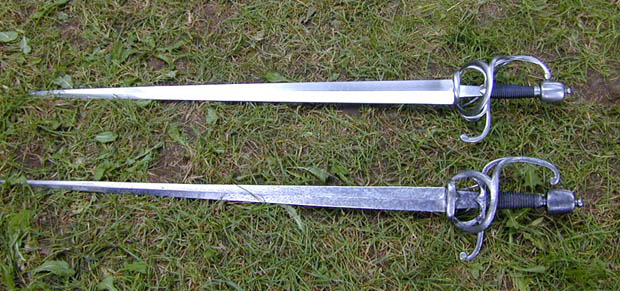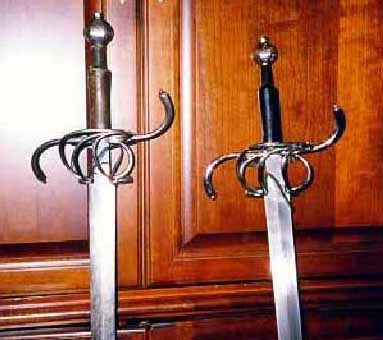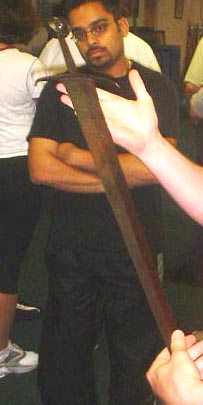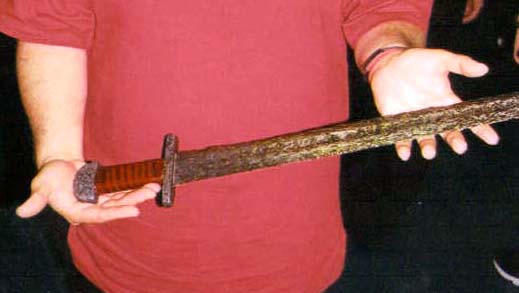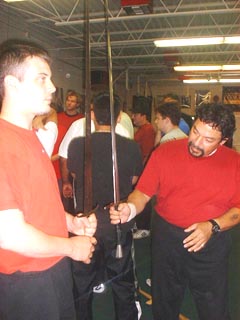|
|
||||||||||||
What did Historical Swords Weight? |
||||||||||||
By J. Clements
Just how heavy were swords from the Middle Ages and Renaissance? This question (perhaps the most commonly encountered in this subject) is easily answered by knowledgeable students of the subject. While understanding of the true weights of Medieval and Renaissance swords is appreciated by serious enthusiasts and practitioners of historical fencing today, in contrast the general public and even specialists are often woefully ignorant on the matter. Finding accurate information on what real historical swords actually weighed can sometimes be difficult, making efforts to convince skeptics and the uninformed a considerable challenge. A Weighty IssueErroneous statements about the weight of Medieval and Renaissance swords are unfortunately common. It is an issue of the most habitual misinformation and misstatement. This should come as no surprise given the misrepresentation Medieval and Renaissance swordplay continually receives in popular media. Everywhere from television and movies to video games, historical European swords have been depicted as being cumbersome and displayed with wide, exaggerated movements. On a recent national television appearance on The History Channel, one respected academic and expert on medieval military technology even declared with conviction how 14th century swords were "heavy" sometimes weighing as much as "40 pounds" (!). From ordinary hands-on experience we know full well that swords were not excessively heavy nor did they weigh 10 or 15 pounds and more. There is only so many ways we can repeat how these weapons were not at all heavy or ungainly. Remarkably, while one would think a crucial piece of information as the weight of swords would be of great interest to arms curators and arms historians, there is no major reference book that actually lists the weights of different types. Perhaps this vacuum of documented evidence is part of the very problem surrounding the issue. However, there are a few respected sources that do give some valuable statistics. For example, the lengthy catalog of swords from the famed Wallace Collection Museum in London readily lists dozens of fine specimens among which it is difficult to find any weighing in excess of 4 pounds. Indeed, the majority of specimens, from arming swords to two-handers to rapiers, weigh much less than three pounds.
The late Ewart Oakeshott. Despite frequent claims to the contrary, Medieval swords were indeed light, manageable, and on average weighed less than four pounds. As leading sword expert Ewart Oakeshott unequivocally stated: "Medieval Swords are neither unwieldably heavy nor all alike - the average weight of any one of normal size is between 2.5 lb. and 3.5 lbs. Even the big hand-and-a-half "war" swords rarely weigh more than 4.5 lbs. Such weights, to men who were trained to use the sword from the age of seven (and who had to be tough specimens to survive that age) , were by no means too great to be practical."(Oakeshott, Sword in Hand, p. 13). Oakeshott, the 20th century`s leading author and researcher of European swords would certainly know. He had handled thousands of swords in his lifetime and at one time or another personally owned dozens of the finest examples ranging from the Bronze Age to the 19th century. Medieval swords in general were well-made, light, agile fighting weapons equally capable of delivering dismembering cuts or cleaving deep cavities into the body. They were far from the clumsy, heavy things they`re often portrayed as in popular media and far, far more than a mere "club with edges." As another source on arms affirmed: "the sword was, in fact, surprisingly light·.the average weight of swords from the 10th to the 15th centuries was 1.3 kg, while in the 16th century it was 0.9 kg. Even the heavier bastard swords which were used only by second-grade fighting men did not exceed 1.6 kg, while the horse swords known as "hand-and-a-half" swords weighed 1.8 kg on average. When due allowances are made, these surprisingly low figures also hold good for the enormous two-hand sword, which was traditionally only wielded by "true Hercules". Yet it seldom weighed more than 3 kg." (Funcken, Arms, Part 3, p. 26). Starting in the 16th century there were of course special parade or bearing swords that did weigh up to 8 or 9 pounds and more, however these monstrous show pieces were not fighting weapons and there is no evidence they were ever intended for use in any type of combat. Indeed, it would not make sense given that there were other far more maneuverable combat models available which were several pounds lighter. Dr. Hans-Peter Hils in his 1985 dissertation on the work of the great 14th century master Johannes Liechtenauer noted that since the 19th century many arms museum collections typically feature immense parade or bearing greatswords as if they were actual combat weapons ignoring the fact they are not only blunt edged, but of impractical size and weight as well as poorly balanced for effective use. (Hils, p. 269-286). Expert OpinionsThe belief that Medieval swords were lumbering or unwieldy to use has virtually taken on the guise of urban folklore and still perplexes those of us who today exercise with such weapons regularly. It is even something of a challenge to try to find a 19th (and even 20th) century fencing author (and even arms historian) who does not unequivocally declare in their writings that Medieval swords were "heavy", "cumbersome", "unwieldy", "clumsy", and (in a complete misunderstanding of the handling, purpose, and application of such diverse weapons) were designed only for "offense." Despite the measurable facts, many are convinced today that these large swords simply are, or even have to be, exceptionally heavy. The view is not one limited to modern times. For example, Thomas Page`s otherwise unremarkable 1746 military fencing booklet, The Use of the Broad Sword, exclaimed nonsense about earlier swords that became largely accepted as fact in the 19th (and 20th) century. Revealing something of how much things in that period had changed from earlier skills and knowledge of martial fencing, declared how their: "Form was rude, and their use without Method. They were the Instruments of Strength, not the Weapons or Art. The Sword was enormous length and breadth, heavy and unwieldy, design`d only for right down chopping by the Force of a strong Arm." (Page, p. A3). Page`s views were not uncommon among fencers then use to featherweight smallswords and the occasional saber and short cutlass. In the early 1870s, Army Captain M. J. O`Rourke, a little-known Irish-American historian and teacher of the sword, in referring to earlier weapons described them as those "ponderous blades, in wielding which they required all the strength of both [hands]." We might also recall pioneer historical-fencing researcher Egerton Castle`s notorious comment about the "clumsy old fashioned sword." (Castle, Schools and Masters of Defence, p. 20 & 22).
Wielding a beautiful specimen of a real 14th century arming sword in order to see how it plays and handles. Quite frequently, some well-meaning academician or elderly curator trained in art history who is not an athlete, not a martial artist, and has not trained in handling historical arms since childhood will declare with authority that a knightly sword is "heavy." The same sword properly wielded in well-conditioned hands will typically be found light, well-balanced, and agile. For example, noted British arms curator Charles Ffoulkes in 1938 declared: "The so-called "Crusader" sword is heavy, broad-bladed, and short gripped. There is no balance, as the word is understood in swordsmanship, and to thrust with it is an impossibility its weight made swift recovery impossible." (Ffoulkes, p.29-30). Ffoulkes` opinion, wholly without merit yet shared by his military co-author Captain Hopkinson, was derived from his understanding of what could be done only with sporting tools in polite contests. Ffoulkes was no doubt basing his opinion on his understanding of contemporary fencing as conducted with the featherweight foils, epees, and duelling sabers of the modern sport (in the same way a tennis racket might feel "heavy" to a ping pong player). Sadly, Ffoulkes in 1945 even stated, "All the swords from the ninth to the thirteenth century are heavy, ill-balanced, and are furnished with a short and unpractical grip." (Ffoulkes, Arms, p. 17). Imagine that, 500 years of professional warriors and fighting men had all gotten it wrong, but a museum curator in 1945 London, who had never been in a real sword fight let alone trained with real swords in any form himself, is able to inform us of the failings of these magnificent weapons. A noted French medieval historian later repeated Ffoulkes` opinion of Medieval swords verbatim as a trustworthy judgment. Respected medievalist and authority on medieval military matters, Dr. Kelly DeVries, writing on military technology of the Middle Ages still referred in a book during the 1990s to "the thick, heavy, awkward, but finely crafted medieval sword." (Devries, Medieval Military Technology, p. 25). With "authoritative" opinions such as these, it is no wonder modern students of the subject have been so ill-informed and we today have so much work remaining. Such opinions on "ponderous old-time swords" as one mid-19th century French fencing master once called them can perhaps be overlooked as products of the climate of the age and the information then available. But at present, similar views expressed by modern students and fencers are not so easily excused. It is particularly sad when leading fencing masters today (schooled only in the weapons of their modern dueling game) will proudly issue naive statements about how much earlier swords weighed. As I wrote in my 1998, Medieval Swordsmanship, "It can be quite pitiful when leading sport fencing maestros (experienced only with flimsy foils, epees, and sabers) will reveal their prejudices with laughable statements about how Medieval swords "weighed 10 pounds" or could only be used for "clumsy bashing and chopping". For example, the respected 20th century fencer Charles Selberg referred to the "heavy and unwieldy weapons of early times" (Selberg, p. 1). While modern fencing master C. L. de Beaumont declared typically: "In the Middle Ages, the general use of armour required weapons, such as the battle-axe and the double-handed sword, to be heavy and clumsy." (de Beaumont, p. 143). Armor required weapons to be heavy and clumsy? Additionally, the 1930, Book of Fencing, with great confidence declared: "With a few rare exceptions, the sword, throughout
Hefting a superb example of a rare 14th century warsword from the famed Alexandria Aresenal collection.
Examining an authentic 15th century great-sword at the British Royal Armorries and a fine 16th century bastard sword at the Glenbow museum, Calgary Such comments reveal more about the biases and ignorance of the writers than about the nature of real swords and swordplay. I`ve personally encountered the same kind of sentiments countless times in public conversations and in Internet chats with fencing instructors and fencing students so I`ve no doubts of its continued pervasiveness. As recently as 2003 one author on medieval knights writing of the longsword stated incomprehensively, "It was so heavy it could even be used to split armor" and further described greatswords as weighing "up to twenty pounds and capable of crushing heavy armor with ease." (A. Baker, p. 39). None of this is accurate. Probably the most damning example that comes to mind is Olympic fencer Richard Cohen in his recent book about fencing and sword history stating early on how, "Swords, which could weigh in excess of three pounds, were heavy and ill-balanced, requiring strength to wield rather than skill." (Cohen, p. 14). With all due respect, even when he accurately acknowledges their weight (in the process denigrating the prowess required to wield them) he nonetheless is still able to consider them only in terms of how they compare to the mock swords of his modern sport, even inexplicably describing them as used "primarily to bludgeon." So, according to Cohen we must imagine that real swords designed by real warriors for real life-and-death combat were heavy, ill-balanced, and didn`t require real skill? But now toy swords for a pretend game are apparently just right?
Handling a fine specimen of a 16th century Swiss war-sword. Sturdy, light, functional. For some reason, many classical fencers still seem to perpetually fail to grasp that earlier swords, being real weapons, weren`t designed to be held at arms length and whipped back and forth by the fingertips. Here we are at the dawn of the 21st century, in the midst of a renaissance of historical European martial arts study, and yet knowledgeable fencers are still perpetuating a 19th century misunderstanding. When you don`t understand how a particular sword is used, it`s not possible to appreciate what its true capabilities are or recognize why it was designed the way it was. Invariably, you end up interpreting it only through the prism of what you already know.
Even basket-hilted broadswords of the 16th century are easy to wield cut-and-thrust weapons. Oakeshott recognized this problematic mixture of ignorance and prejudice more than three decades ago, writing in his influential, Sword in the Age of Chivalry, he noted: "Add to this the work of romantic writers in the past, who, seeking to give to their heroes a touch of the Superman, caused them to wield enormous and weighty weapons far beyond the powers of modern man, and complete the picture with the scorn poured upon these swords by lovers of the elegance of the 18th century and it becomes easier to see why so plain a weapon can be accounted crude, ponderous, and inefficient. In fact the average weight of these swords is between 2 lbs. and 3 lbs., and they were balanced (according to their purpose) with the same care and skill in the making as a tennis racket or a fishing rod. The old belief that they are unwieldable is as absurd and out-dated, and dies as hard, as the myth that armored knights had to be hoisted into their saddles with a crane." (Oakeshott, Sword in the Age of Chivalry, p. 12).
Working-out with a superb example of an actual 15th century estoc. Only by vigorously putting such weapons through their paces can we be sure about their performance. Long-time student of arms and senior fight interpreter at the British Royal Armouries, Keith Ducklin, states: "From my experience at the Royal Armouries, where I have handled many genuine weapons from different periods, I would personally suggest that a broad-bladed European fighting sword, be it a cutter, cut-and-thruster or thruster, is likely to weigh between two pounds for a single-handed sword and four-and-a-half for a two-handed. Swords specifically produced for other uses, e.g. ceremony or execution, may weigh less or more, but these are not fighting weapons." (personal correspondence with the author, April 2004). Mr. Ducklin would certainly know, as he has held and examined literally hundreds of fine swords in this famous collection and considered them from the point of view of a fighter. In a brief article on swords specimens of the 15th to 16th centuries from three major museum collections, including samples from the Stibbet Museum in Florence, Dr. Timothy Dawson noted no single-hand sword weighed more than 3.5 pounds and no greatsword weighed more than 6 pounds. He concludes, «From these examples it can be seen that the ideal that medieval and Renaissance swords were heavy, clumsy objects is far from true.» (Dawson, p. 34 & 35). Subjectivity and Objectivity
The fact is, if you know what you are doing, understand the necessity of the fighting style, and the dynamics of the weapon, then Medieval and Renaissance swords can rightly feel agile and robust.. Writing in 1863, the sword manufacturer and authority John Latham of Wilkinson Swords mistakenly noted of a fine specimen of a mid-14th century Medieval arming sword that it had «a tremendous weight» because «it was intended for a time when swordsmen had to deal with iron-plated men.» Added, Latham, «They got the heaviest weight they could, and they put as much force behind it as they could possibly give.» (Latham, Shape, p. 420-422). Yet, commentingon the «overweighting» of swords, Latham however noted a 6-pound sword designed at the time by a cavalry officer who imagined it would strengthen his wrist but the result was that «no living man can cut wit hit…The weight is so great that it is impossible to give it any velocity, and it’s cutting power is therefore nil. A very simple test shows this.» (Latham, Shape, p. 420-421). Latham also added that, «The nature of the body cut at, however, affects the result very much.» He then concluded by commenting that the common mistake is to believe a strong man would take a heavier sword so he could do more damage with it. «The weight a man can move with the greatest velocity is that with which he will produce the greatest effect, but the lightest sword is not necessarily the one he can move the quickest. It is possible for a sword to be so light that we feel the resistance of the air in making a cut with it, and this is what we express when we say a sword feels ‘whippy’ in the hand. Such a sword is worse than one too heavy.» (Latham, p. 414-415). A sword certainly had to have enough mass to support an edge and point, parry strikes, and give a blow weight, but at the same time it could not be so heavy as to be slow and unmanageable or else a quicker weapon would fight circles around it. This necessary weight was a factor of what the blade was designed for, whether to cut, thrust, or do both against whatever particular materials it would encounter. Imaginary tales in chivalric fiction often featured massive swords wieldable only by heroic champions or great villains and capable of cleaving through horses and even trees. But these accounts were mythic and allegorical, not literal. In Froissart`s Chronicles, when the Scots defeat the English near Melrose we do read of Sir Archibald Douglas who "wielded before him an immense sword, whose blade was two ells long, which scarcely another could have lifted from the ground, but he found no difficulty in handling it, and gave such terrible strokes, that all on whom they fell were struck to the ground; and there were none so hardy among the English able to withstand his blows." The great 14th century fencing master Johannes Liechtenauer himself said, "the sword is a scale, and it is great and heavy" and that it is balanced by a suitable pommel, by which he meant that the weapon is itself "balanced" and handles well from that balance, not that the sword was weighty. The Italian master Filippo Vadi in the early 1480s instructed, "You`ll take a light weapon and not a heavy one, to easily control all of it, to avoid being hindered by heavy weight." Thus, we have a teacher of defense specifically acknowledging there were both "heavy" and "light" blades to choose from. But again, the word "heavy" should not be taken as equivalent with being "too heavy" or necessarily awkward and cumbersome. Instead, it should be viewed in the same context as one might, for instance, choose a heavy tennis racket over a light one or a heavier baseball bat over a lighter one.
So many fine Medieval and Renaissance swords are so perfectly balanced and weighted, they seem to virtually cry out to the holder, "Wield me!" In my experience, having handled in arms museums and private collections well over 200 fine European swords ranging from the 12th to 16th centuries alone, sword weight is something I have paid careful consideration to. I am consistently amazed at the liveliness and balance of virtually every specimen I encounter. The antique Medieval and Renaissance swords I have personally examined in six countries, and in some cases practiced and even cut with, were time and again light and well-balanced. Being accustomed as I am from years of exercise swinging blades and handling weapons, with extremely few exceptions did I ever find a historical sword to be anything other than agile and quite manageable. Few, if any fighting swords, from short blades to bastard variety and rapiers weighed even close to 4 pounds and those which did typically were still well-balanced. Even when I came across a piece I personally found "too heavy" or just not balanced for my own tastes, I recognized there might be others with a different build or fighting style who no doubt could find it appealing.
ARMA members investigating swords at the Swedish Royal Armory, Stockholm. On an occasion when I worked out with two 16th century war-swords, each weighing just over 3 pounds, they performed beautifully; nimbly cutting, thrusting, guarding, recovering, and arcing around in rapid slashes and fierce full-arm cuts as if they were nearly weightless. There was nothing "heavy" about such fearsome and elegant tools. I recall during one wonderful opportunity to floryshe outside for several minutes with an actual 16th century two-handed infantry sword, my being entirely surprised at how easily the immense 6 pound weapon handled so that it readily felt as if it weighed half as much. Even though it was not designed for someone of my stature, I could see its clear functionality and utility because I understand the techniques and methods for such weapons. The reader can take such anecdotes for what they are worth. But the countless times that I have hefted fine antique swords from the 14th, 15th, or 16th centuries, posing in wards and performing stance transitions with them under the watchful eyes of benevolent curators, have left me with the unshakeable conviction as to what real swords weighed (and how they really handled).
Measuring and weighing two excellent specimens in a private collection. At one time, while inspecting a few select 14th and 16th century swords in the possession of the late Ewart Oakeshott, we even had the opportunity to weigh several fine examples on a digital scale just to confirm and record for ourselves an accurate understanding of their weight. Other colleagues have done similar things and their findings corroborate with ours. It is from such experiences with real swords that ARMA has come to be so critical of the weight and balance problems so widespread in many (certainly not all) modern swords. My experience with real blades makes me all the more disappointed in the current inferior accuracy of many modern versions. Obviously, the more a modern sword handles like a historical one, the more accurate our interpretations of the historical teachings for using it will be. Indeed, it is arguable that appreciation for the true weight of historical swords is prerequisite to understanding their true application. Having handled countless Medieval and Renaissance swords to collect impressions and exact measurements for his work, respected swordsmith Peter Johnsson tells us how they, "have a feeling of agility about them that can be astounding. In general they are quick and precise and expertly well balanced for their intended use. You get a strong impression of lightness that often belies the actual size and weight of the sword. This is more a result of a careful distribution of mass than just the placing of the point of balance. Finding the weight of a sword and its "point of balance" is only half way to understanding its "dynamic balance" (i.e., how the sword handles when put in motion)." He adds, "In general, modern replicas are very far from original swords in this respect. Distorted impressions as to what authentic sharp weapons were all about can easily result from enthusiasts today learning only by training with modern weapons." Thus, as Johnsson notes, the bottom line is again that real swords are lighter than most people realize. Even then, weight is not the whole story because handling characteristics are a matter of mass-distribution along a blade, which in turn, affects the point of balance. What needs to be understood in regard to modern copies of historical swords is that even when made to closely approximate the weight of an actual historical specimen, this does not guarantee at all that it will feel the same as, or handle identically to, the original model. Unless the geometry of a reproduction matches that of the original (i.e., along its entire length, shape, and cross-section) the balance will not be identical between them.
Carefully weighing and measuring some actual 14th & 16th century pieces.. The modern piece can easily feel heavier and be less wieldy than the original. Accurately reproducing balance in swords today is an important aspect of their construction. Nowadays, many cheaply made and inferior swords whether historical replicas, reenactment weapons, fantasy-designs, theatrical props, or ornamental pieces are regularly made heavy with poor balance. Part of this problem is due to an unfortunate lack of understanding of blade geometry on the part of the manufacturer. Other times, intentional cost-cutting considerations are to blame. Either way, even if they know, sellers and makers cannot be expected to acknowledge to consumers that their swords may be too heavy or poorly balanced. It`s apparently much easier to simply offer statements to the public about how they are "supposed" to be that heavy. There is another factor in why modern swords are typically made heavier than historical originals. Out of ignorance many sword makers and their consumers honestly expect that a sword should feel heavy. They have been conditioned by endless displays of lumbering swordsmen with great sweeping blows of slow blades to believe that unless their "barbarian broadsword" is hefty and causes strain when lifted, it can`t be a "real" sword as if sheer mass alone affects a successful sword blow. [When contrasted with the lightening-quick featherweight aluminum swords used in many Asian martial arts displays and choreographed routines, its hard to blame anyone for such misunderstanding.] While the difference between a 3.8 pound and a 5.3 pound blade may not seem like all that much, when trying to correctly perform proper fighting techniques it very much is. Additionally, when it comes to rapiers, which generally weighed between two and two-and-a-half pounds, their weights can be somewhat misleading. Being such slender thrusting blades, rapiers often have the majority of their mass at their hilts, giving them a balance that lends agility to their points despite their weight comparative to much wider cutting swords.
Trying out an authentic 16th century two-handed infantrysword. Facts and Myth-conceptionsInterestingly, several times I have been fortunate to have had the opportunity to compare a modern reproduction side by side with the original sword it was based on. Though there was a difference of only few ounces in weight, the disparity made the new one seem to weigh at least a pound heavier.
Two weapons, a fine replica, and an original. Despite being very close in dimensions and weight, there is no comparing the difference in"feel" betweeen the two.
Two of examples of modern reproductions side by side with their originals. Despite their having the same dimensions, the minute and subtle differences in cross-sectional geometry between them (the mass distribution in the tang, the shoulder, the edge bevel, etc.) was dissimilar enough to severely affect the balance and thus, their "feel" when handled. I`ve also had the remarkable opportunity to examine 19th century forgeries of Medieval swords and in some cases the difference in "feel" between these fakes and the real thing were noticeable right away. When showing replica swords in my lectures and presentations over the years, I have repeatedly experienced surprise from attendees who discover for the first time that swords were not nearly as stocky or burdensome as they assumed or expected. Their surprise is often accompanied by questions as to how to enlighten others to this. As well, when teaching beginners I`ve very often heard comments as to how heavy a particular sword was that, in contrast, senior ARMA students actually considered to be fairly light and well-balanced.
Examining historical blades: A 14th century arming sword without handle, a 10th century Viking sword, and a 16th century military field sword. Just how can one respond intelligently when confronted with insistent declarations that swords "had to be heavy" or "weighed 20 pounds?" How best to go about factually refuting such nonsense statements? I have no sure advice. If you directly answer that Medieval and Renaissance swords were light, agile, and typically weighed around three pounds, you can often expect to be met with a certain disbelief and even argument. All that can be done perhaps, is to suggest that the other party may not fully appreciate the true attributes of real swords, that they may have been misled as to the actual weights of historical pieces, that they might consider whether or not they have ever handled sufficient historical examples, and finally, that they might realize historical fighting men trained hard and kept fit. The many types of Medieval and Renaissance swords were versatile, agile, and highly effective weapons that`s why they were around for so long in so many forms. As a tool of self-protection, nothing clumsy or awkward to use would have been continually popular for centuries. Claims that they consisted merely of crude hacking and artless chopping without true skill, insult how versatile and elegant these fighting blades really were.
ARMA Members contrasting two pieces, an original and a similar modern reproduction. Good swords were light, agile, well balanced, and though fairly stiff, still flexible and resilient. They were killing tools and their study should be approached from that understanding. A sword`s weight cannot be judged just from its size or blade width. Thus, while the weight of Medieval and Renaissance swords can be accurately recorded and compiled, the matter of their being "heavy" or not is one of perspective. It is clear that despite the facts, regardless of the objective mass of historical swords, their "heaviness" is a subjective matter. The same three-pound weapon is elegant and robust to a skilled practitioner while his desk-bound colleague might think it ungainly and sluggish. The understanding we must have is that to the men who skillfully used these tools, they weighed just right. |
||||||||||||
